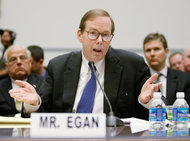Q. How do you hire?
A. The most important thing is to have a framework that everybody in the company knows. So we said: Let’s just come up with something very simple that is easy to understand and that people can use every day in their interviewing skills.
The first is to hire people who are experts in their domain. It’s really about excellence. So I will ask people, “Are you an expert in your field, and if you are, help me understand your field.” Then I ask, “How did you acquire this knowledge?”
The second thing I’m looking for is “sparkle.” Is this person contagiously enthusiastic? You may be an expert in your field, but if you don’t communicate well, or if you don’t get people excited, or you’re not passionate or enthusiastic, that’s going to be a hindrance. And it’s not the difference between being introverted or extroverted — you can just see it in somebody if they have the magic.
The third thing we look for is people who just get stuff done. We’re very focused on metrics — we have goals and controls, and everybody in the company has them. We even have a rating system we use to score employees, from 1 to 5, based on their “getting stuff done” index every quarter. People take the scoring concept very seriously, and really like the accountability and the transparency around some of these things — and the fact that they’re empowered to get stuff done.
The other critical thing we’ve done in our hiring process is to require every candidate to do homework. It varies by department and by function, but every hiring manager has to have a homework assignment for open positions. We just hired a director-level marketing position, and they had to come in and present their plan for what they would do for the company to drive their marketing strategy.
I’ve found that there are so many biases that we create or imagine when we’re going through the hiring process — this person came from that school or they seem very polished, whatever the biases might be. But when you have them put pen to paper, and compare that against a field of candidates, you get a much clearer picture of how they think and work.
We also don’t set deadlines for handing in the homework. We let them set the deadline, but then we track very closely how they perform relative to that. So we’d never say, “You owe us the homework by tomorrow.” We would say: “We’re very interested in you, and we’d like you to do some homework, and here’s the assignment. Do you have any questions about that? And when would you like to submit the homework?” That’s one way we can test for their behavior — do they get it done on time, or do they make excuses because it’s late? What I’ve found from all the interviews I’ve done in the last 10 years is that whatever nagging suspicion you have during the interview process about their behavior will be magnified 10 times after you hire them.
Q. You mentioned the importance of having shared goals in the organization. Can you elaborate?
A. I think organizations have a hard time communicating up and down the chain of command and getting everybody mobilized to focus on the same goals. I’ve experienced that firsthand — whatever your task or scope of work, you don’t know how that connects to your manager and your manager’s manager, and how that is all kind of interconnected.
So the biggest thing we focus on is this concept of “interlock.” It’s about how we get all the departments connected with their goals — from the C.E.O. to the front-line person — so that all of those goals and controls are transparent. Everybody should know what everybody’s goals and controls are, and everybody should understand their individual ones relative to their department, and their department’s goals relative to the company’s.
This interview has been edited and condensed.
Article source: http://www.nytimes.com/2013/03/10/business/kris-duggan-of-badgeville-on-the-getting-stuff-done-index.html?partner=rss&emc=rss
